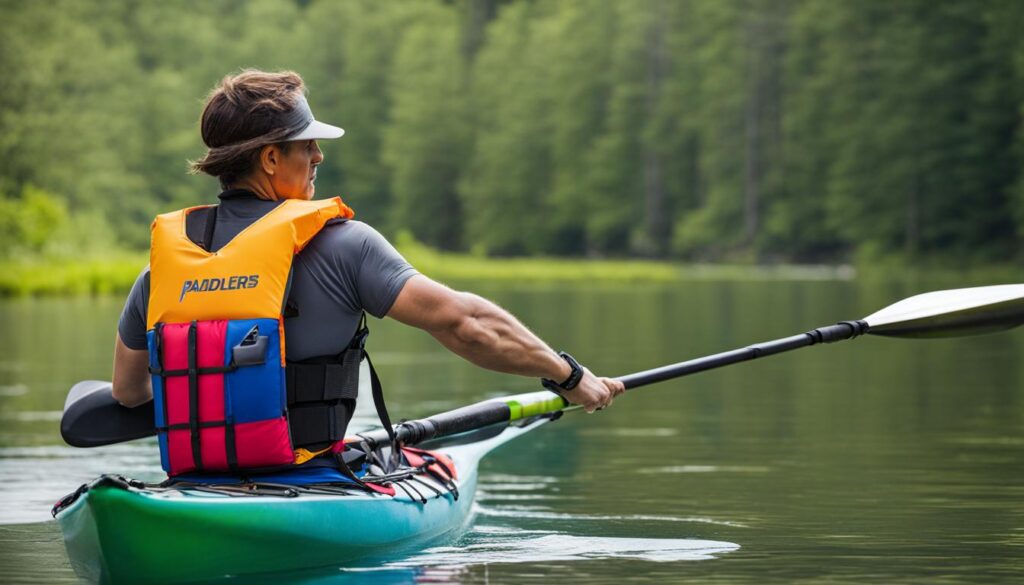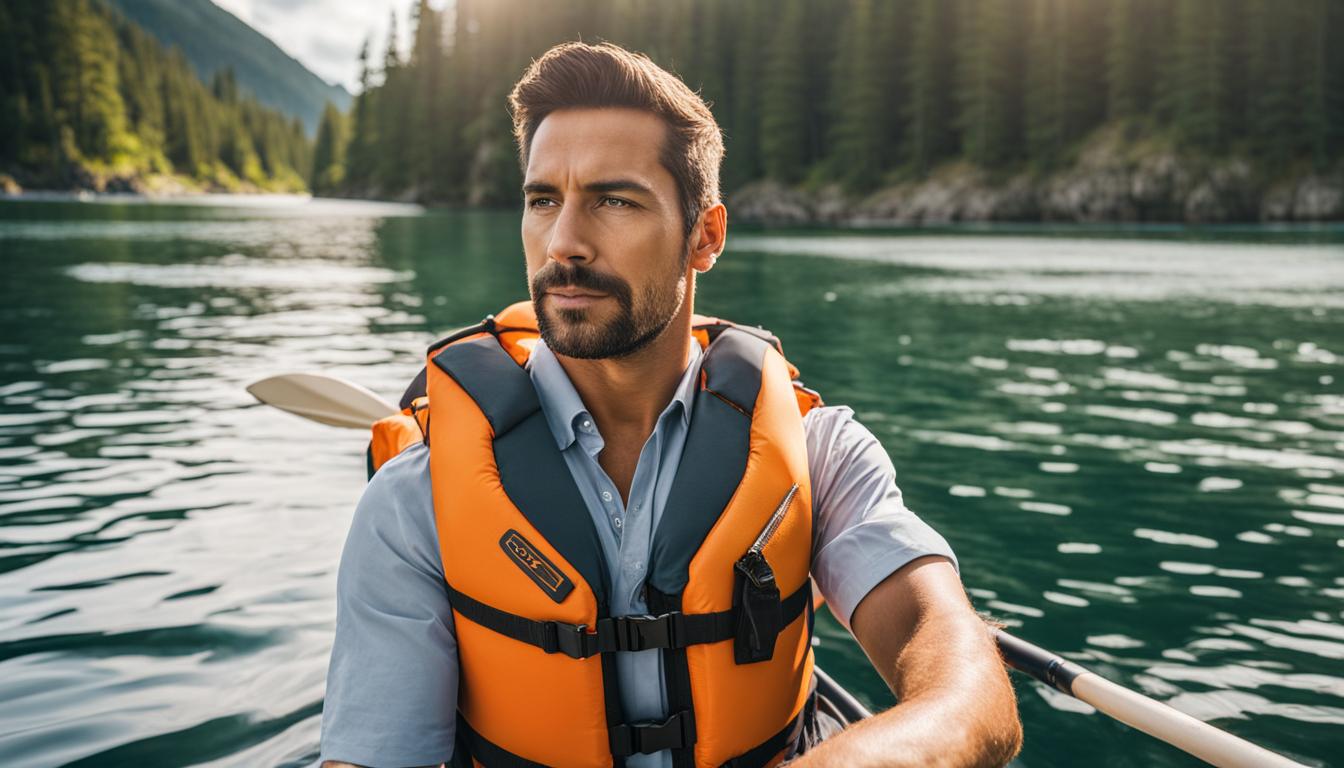A personal flotation device (PFD) is an essential piece of gear for kayakers, canoeists, and stand-up paddle boarders. It provides buoyancy to help you stay afloat in water. When choosing the right life vest, there are several factors to consider.
Standard PFDs and inflatable PFDs are the two main types available. Standard PFDs are low-maintenance and versatile, suitable for various water sports. They typically have pockets for storage. Inflatable PFDs are more comfortable and less bulky, but they require inflation before providing flotation. Hybrid PFDs are a combination of standard and inflatable PFDs.
To ensure a proper fit, sizing for adults is based on chest size, and a snug-but-comfortable fit is essential. It’s also important to consider PFD features and specifications such as pockets, color, tabs, and flotation. The most important tip is to always wear a PFD to prioritize safety on the water.
Key Takeaways:
- Consider the type of PFD that suits your needs – standard, inflatable, or hybrid.
- Ensure a proper fit by measuring your chest size and checking the manufacturer’s size recommendations.
- Take into account the PFD features and specifications, such as pockets, color, tabs, and flotation.
- Prioritize safety by always wearing a PFD while on the water.
- Choose a PFD that is comfortable and allows for freedom of movement during paddling.
Standard PFDs vs. Inflatable PFDs
When it comes to choosing a life vest for your kayaking adventures, you have two main options: standard PFDs and inflatable PFDs. Each type has its own set of advantages and considerations, so let’s take a closer look at the differences between them.
Standard PFDs:
Standard PFDs are the most common type used by recreational paddlers. These Type III USCG-approved life vests rely on foam flotation material to provide buoyancy. They are generally low-maintenance and versatile, making them suitable for various water sports. Most standard PFDs also come with pockets for storage, allowing you to keep essentials like snacks, tools, and gear within easy reach. While they provide excellent flotation and functionality, some paddlers find them bulky and hot, especially during the summer months.
Inflatable PFDs:
Inflatable PFDs are gaining popularity among paddlers due to their comfort and slim profile. They are available in vest or waistpack styles and are labeled as Type III or Type V USCG-approved life vests. Inflatable PFDs offer a more lightweight and streamlined design, making them comfortable to wear for long periods. However, it’s important to note that they require inflation before providing flotation. Inflatable PFDs can be manually or automatically inflated, depending on the model. While they offer enhanced comfort, they are not suitable for high-impact activities or non-swimmers.
PFD Sizing and Fitting
When it comes to choosing a life vest for paddlers, getting the right fit is crucial for both comfort and safety. Here are some essential tips to consider:
Determining the Correct Size
Unlike other types of clothing that might be based on weight or height, life vests are sized based on chest size. To find the right fit, measure the circumference of your chest at its broadest point. Use the manufacturer’s size chart to determine the appropriate size for you. Remember, a life vest should fit snugly but comfortably, allowing for free movement while paddling.
Consider the Paddling Environment
When selecting a life vest, it’s important to consider the specific paddling environment. For kayakers, shorter PFDs typically work best as they won’t interfere with the seat. If you paddle in warmer climates, look for vests with ventilation features to keep you cool. If you frequently paddle in low-light conditions, consider a vest with reflective tape for added visibility.
Try Before You Buy
To ensure the perfect fit, it’s always wise to try on a life vest before making a purchase. Put it on with the clothes you would typically wear while paddling and simulate paddling motions. Check for any uncomfortable pressure points or restrictions in your range of motion. It’s also a good idea to try the vest in water to see how it feels when wet. Additionally, women-specific PFDs are available, designed to accommodate the female body shape more comfortably.
By finding a life vest that fits properly, you can ensure a comfortable and safe paddling experience. Remember, the right fit is just as important as the features and specifications of the PFD itself.

| Size | Chest Circumference (in inches) |
|---|---|
| Small | 32-36 |
| Medium | 36-40 |
| Large | 40-44 |
| X-Large | 44-48 |
| XX-Large | 48-52 |
PFD Features and Specs
When choosing a life vest for kayaking, it’s important to consider the various features and specifications that can enhance your experience and safety on the water. Here are some key factors to keep in mind:
High-Visibility and Reflective Elements
One of the essential features to look for in a kayaking life vest is high-visibility coloring and reflective elements. These help ensure that you are easily visible to other boaters, especially in low-light conditions or during emergencies. Bright colors like yellow, orange, and neon green are highly recommended for enhancing your visibility on the water.
Multiple Pockets for Storage
A life vest with multiple pockets can be incredibly useful for storing small essentials while you’re out paddling. These pockets allow you to keep items like snacks, a water bottle, sunscreen, a whistle, or a small first aid kit within easy reach. Look for vests with secure zippers or Velcro closures to prevent items from falling out during movement.

Comfort and Ventilation
Comfort is key when it comes to any outdoor activity, including kayaking. Look for life vests that are designed with adjustable straps and side panels to ensure a snug yet comfortable fit. Additionally, vests with mesh ventilation panels help to keep you cool and prevent overheating during hot summer paddling sessions.
| Life Vest Style | Key Features |
|---|---|
| Kayak Touring | – High-back design for kayak seats – Large pockets for gear storage – Reflective elements for visibility |
| Whitewater Kayaking | – Shorter length for freedom of movement – Reinforced panels for durability – Rescue harness compatibility |
| Kayak Fishing | – Rod holder attachments – Tool hangers and loops – Additional storage options for tackle boxes |
These are just a few examples of the different styles of life vests available for specific types of kayaking. Consider your preferred kayaking style and activities when choosing the right life vest to meet your needs.
By taking into account these various features and specifications, you can select a life vest that not only provides the necessary safety but also enhances your enjoyment of kayaking adventures.
Conclusion
Choosing the right life vest is crucial for the safety of kayakers like you. Whether you prefer a standard PFD, inflatable PFD, or hybrid PFD, the most important consideration is a comfortable fit and proper flotation. Prioritize your specific needs and preferences when selecting a PFD for your water activities.
Always remember to wear a PFD and make sure it fits well on your body. Safety should never be compromised. By following these tips and recommendations, you can confidently enjoy your kayaking adventures while staying safe on the water.
Shop for a PFD that meets your requirements and provides the necessary safety features. With the right safety vest selection, you can have peace of mind knowing that you are well-equipped for any kayaking excursion.
FAQ
What is a PFD?
A personal flotation device (PFD) is a life vest or life jacket that provides buoyancy to help you stay afloat in water.
What are the main types of PFDs available?
The main types of PFDs available are standard PFDs and inflatable PFDs. There are also hybrid PFDs, which are a combination of standard and inflatable PFDs.
What are the differences between standard PFDs and inflatable PFDs?
Standard PFDs are low-maintenance and versatile, suitable for various water sports. They typically have pockets for storage. Inflatable PFDs are more comfortable and less bulky, but they require inflation before providing flotation.
How do I choose the right size PFD?
For adults, sizing is based on chest size. It is recommended to measure the circumference of the chest at its broadest point and use the manufacturer’s size recommendations to find the right size.
How should a PFD fit?
A PFD should have a snug-but-comfortable fit, allowing for free movement and no chafing while paddling. It is also essential to consider how the PFD works with the seat, especially for kayakers.
What features should I look for in a PFD?
Some common features to consider include pockets for storage, bright colors for visibility, tabs to attach accessories, reflective tape for low-light conditions, ventilation for hot locations, and fishing-specific features.
How much flotation do I need in a PFD?
Most adults need just an extra seven to twelve pounds of flotation to stay afloat, and any quality PFD will provide more than this amount.
Are there different types of PFDs for different water activities?
Yes, the U.S. Coast Guard (USCG) classifies PFDs into different types. For kayaking, canoeing, and stand-up paddle boarding, Type III and Type V PFDs are typically the most comfortable and suitable choices.
What is the most important tip when it comes to PFDs?
The most important tip is to always wear a PFD to prioritize safety on the water.





